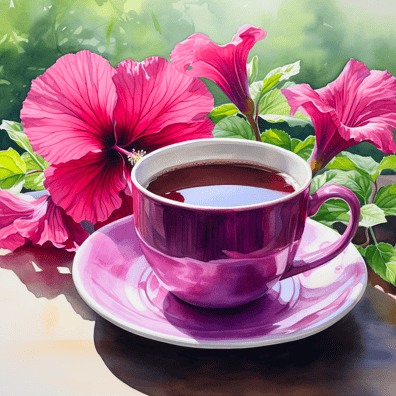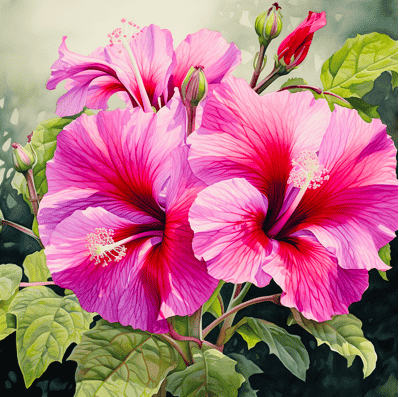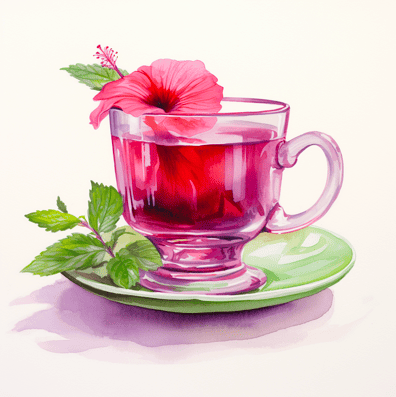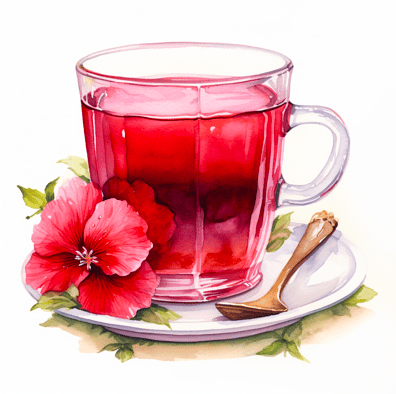
Don’t want to read the whole post?
To make hibiscus tea from the plant, harvest the mature calyxes of the Hibiscus sabdariffa when they are bright and shiny. Steep the dried or fresh calyxes in boiling water for about 5-7 minutes, then strain and enjoy hot or cold, with optional sweeteners like honey or sugar for taste
ABOUT ME
Be beauty. Be plant-based!
As a former Registered Nurse and avid plant-muncher, I’m in love with how simple plant-based foods make it easy to be beautiful.

You’ll also love:
Acid Alert: Is Hibiscus Tea Acidic?
Today, we’re embarking on a delightful journey to make hibiscus tea from plant right in your own home. Imagine sipping a cup of this vibrant, health-boosting brew, infused with the natural goodness of fresh hibiscus flowers. It’s not just a drink; it’s a way to embrace a more natural, plant-based lifestyle, full of flavour and wellness benefits.
Growing Your Own Hibiscus
Choosing the Right Hibiscus: When it comes to making your own tea, the Hibiscus sabdariffa variety stands out. Known for its deep red hue and tart flavour, this species is not just beautiful to look at but also packed with health benefits. Whether you have a small garden or a sunny windowsill, growing this plant can be a fulfilling experience.

Planting Tips: Your hibiscus journey begins with planting. These plants love warm, sunny spots and thrive in well-drained soil. They are perfect for USDA zones 8-11, but don’t worry if you’re not in these zones. With some care, you can grow them indoors too. Start with organic seeds or young plants from a nursery. Remember, the happier your plant, the more flavourful your tea!
Caring for Hibiscus: Hibiscus plants are not just pretty; they’re also quite hardy. They prefer regular watering, especially during dry spells, but be careful not to overdo it. Keep the soil consistently moist but not waterlogged.
Hibiscus sabdariffa loves the sun, so make sure it gets plenty of light – at least six hours a day. With a bit of love and attention, your hibiscus will soon be ready to contribute to your tea-making adventures.
By choosing the right variety, planting it in the perfect spot, and giving it the care it needs, you’ll be well on your way to enjoying your very own homemade hibiscus tea. Stay tuned for the next steps in this exciting journey!
Harvesting Hibiscus for Your Tea
Timing for Harvest: The right time to harvest hibiscus for your tea is when the flowers are in full bloom. You’ll know the calyxes (the protective layers around the flower) are ready when they’re bright and shiny, indicating peak freshness. This is crucial for capturing the essence of the hibiscus in your tea, ensuring a vibrant colour and rich flavour.
Harvesting Method: Once your hibiscus has reached this point of maturity, it’s time to gather your ingredients for that perfect pot of hibiscus tea. Gently snap off the ripe calyxes from the base of the flower. These are the parts you’ll be using for your tea. Be gentle to avoid damaging the plant, ensuring it continues to thrive for future harvests.
Preparing Hibiscus for Tea
Drying Fresh Flowers: After harvesting, you’ll need to dry your flower petals and calyxes to make dried flowers. Spread them out on a clean surface in a well-ventilated, dry area away from direct sunlight. This drying process concentrates the flavours and makes the petals perfect for brewing tea. It might take a few days for them to dry completely, so be patient.

Cleaning Fresh Flowers: If you opt to use fresh flowers instead, make sure to clean them thoroughly. Gently rinse the hibiscus leaves and flower petals under cold water to remove any dirt or bugs. Remember, the cleaner your flowers, the more pristine and refreshing your hibiscus tea will be.
In these stages, you’re transforming the vibrant hibiscus from your garden into the main ingredient for a refreshing and healthful tea. The effort put into growing and preparing your hibiscus will soon pay off in the form of a delicious, homemade beverage. Stay tuned for the next steps where we’ll dive into brewing this exquisite tea.
Brewing Hibiscus Tea
Using Fresh Flowers: If you’re using fresh hibiscus flowers, the process is quite straightforward. Place the clean petals in a teapot or a large cup. Then, pour boiling water over them, making sure they’re fully submerged. This method extracts the fresh, tangy essence of the hibiscus directly into your hot cup of tea.

From Dried Flowers: For those using dried flowers, the process is slightly different but just as rewarding. Place about two teaspoons of dried hibiscus petals in your tea infuser or directly into the pot. Boil water and pour it over the petals. The hot water helps to release the deep flavours and vibrant colours of the hibiscus, creating a rich and satisfying tea.
Customising Your Tea
Exploring different ways to enjoy hibiscus tea can be a delightful experience. Whether you prefer it hot or cold, there are several variations and customisations to suit every taste.
- Agua de Jamaica: This traditional Mexican drink is an iced tea version of hibiscus tea (also known as flor de Jamaica). It’s made by adding lime juice, ice and a sweetener of your choice to brewed hibiscus tea. You can use sugar, honey, or agave syrup, depending on your preference. Agua de Jamaica is renowned for its refreshing quality, especially on a hot day.
- Iced Hibiscus Tea: Ideal for cooling down during hot weather, iced hibiscus tea is both refreshing and visually appealing with its bright red colour. Brew the hibiscus tea, let it cool, then pour it over ice cubes in a glass. For an extra twist, garnish with a slice of lemon or lime.
- Karkade Tea: Originating from Egypt, karkade tea is known for its unique tart flavour. It’s typically made with dried hibiscus flowers and is often served both hot and cold. Adjust the sweetness to your taste to enjoy this variant.
- Sweetening Your Tea: While hibiscus tea has a naturally tangy flavour, you may want to balance this with a sweetener. Natural sweeteners like honey and maple syrup complement the floral notes perfectly. Regular sugar is also a good option for a more traditional taste.
- Adding Flavours: Infusing your hibiscus tea with additional flavours can add depth. A cinnamon stick can introduce a warm, spicy note, while lemon zest enhances the citrusy undertones. Experiment with these additions to create your perfect cup.
Each of these variations and customisations offers a unique way to enjoy hibiscus tea, making it a versatile beverage suitable for any occasion. Whether you prefer it hot or cold, sweetened or tart, hibiscus tea remains a delightful drink that’s as enjoyable to make as it is to sip.
Health Benefits of Hibiscus Tea
Boosting Wellness: Hibiscus tea is not just a delicious beverage; it’s also a powerhouse of health benefits. Rich in vitamin C, it’s excellent for boosting the immune system and fighting free radicals. For those focused on weight loss, hibiscus tea can be a great addition to your diet due to its diuretic properties and ability to help in metabolism.
Managing Health: Hibiscus tea is also known for its positive effects on blood pressure. It can aid in lowering high blood pressure as well as managing low blood pressure. Additionally, it’s beneficial for maintaining healthy blood sugar levels, making it a great choice for those monitoring their glycemic index.
Enjoying Your Tea
Your freshly brewed hibiscus tea can be enjoyed in many ways. A hot cup of tea is perfect for relaxing evenings, while an iced version is ideal for a refreshing drink on a warm day. Add a dash of lemon juice or lime juice for an extra zing. For a decorative touch, garnish with a slice of lemon or a sprig of mint.

How to make hibiscus tea from plant
Enjoying a cup of hibiscus tea from plant is more than just a delightful experience; it’s a journey into a healthier, more natural lifestyle. From the moment you choose to grow Hibiscus sabdariffa in your garden, to the harvesting of its vibrant red hibiscus petals in full bloom, and finally to the brewing and customising of your tea, every step is a testament to the beauty and benefits of a plant-based diet.
FAQ: How to Make Hibiscus Tea
Can you make tea from any hibiscus plant?
Not all hibiscus plants are suitable for making tea. The best variety for tea is Hibiscus sabdariffa, also known as Roselle. This variety is specifically used for culinary purposes, including tea making, due to its edible calyces and pleasant tart flavour. Other hibiscus species, especially ornamental ones, might not be suitable for consumption and can have different flavours or potentially harmful effects.
What part of the hibiscus plant is used for tea?
The part of the hibiscus plant used for making tea is the calyx, which is the green, outer protective layer of the flower. After the flower blooms and falls off, what remains is the calyx, which turns into a deep red, fleshy structure. These calyces are harvested, dried, and then used to make tea. They give the tea its characteristic deep red colour and tart flavour.
What not to mix with hibiscus tea?
While hibiscus tea is generally safe and healthy, it’s advisable not to mix it with certain medications due to potential interactions. Specifically, it’s important to be cautious if you are taking medication for diabetes or high blood pressure, as hibiscus can also lower blood pressure and blood sugar levels. Additionally, because of its tart, acidic nature, it might not mix well with dairy products as it can curdle milk. As always, if you’re unsure or have specific health concerns, it’s best to consult with a healthcare professional.